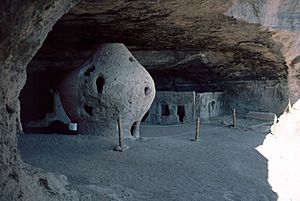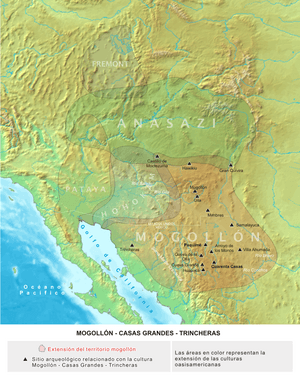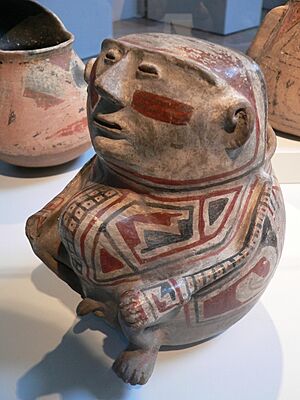Cueva de la Olla (archaeological site) facts for kids

Archaeological site
|
|
| Location | Nuevo Casas Grandes Municipality, Chihuahua, Mexico |
|---|---|
| Region | Mesoamerica, Oasisamerica |
| Coordinates | 30°09′10.73″N 108°19′33.25″W / 30.1529806°N 108.3259028°W |
| History | |
| Founded | 950 |
| Abandoned | 1060 |
| Periods | Paquimé "Perros Bravos" Phase |
| Cultures | Mogollon - Paquimé |
Cueva de la Olla means "cave of the pot" in Spanish. It is an ancient archaeological site in the Valle de las Cuevas (Valley of the Caves). You can find it in northwestern Chihuahua, Mexico. It's about 47 kilometers southwest of Nuevo Casas Grandes.
The site gets its name from a large, pot-shaped storage building found there. This type of building is called a cuexcomate. It was like a giant barn used to store food. Similar storage places were once common in caves across the Sierra Madre Occidental mountains. Cueva de la Olla is one of the oldest archaeological sites in Chihuahua and Mexico.
The Valley of the Caves shows signs of people living there for a very long time. Early human groups in this area grew an ancient type of maize (corn) as far back as 5500 BCE. Because winters were very cold, people needed to store food. So, they built these special barns, which you can still see today, even though they are old.
Contents
Ancient Cultures of Cueva de la Olla
Long ago, groups of hunter-gatherers came to this region from the north. They might have been connected to the Mogollon, Anasazi, and Hohokam cultures. These people followed the Sierra Madre Occidental mountains. They gathered plants and hunted small animals like turkeys.
At first, they lived in the mountains. Over time, they moved to river valleys. This led to the growth of the Paquimé culture in the Casas Grandes area. The very first people here were hunter-gatherers who were learning to settle down and farm.
Cueva de la Olla was used during an early time called the Perros Bravos (Fierce Dogs) phase. This period lasted from 950 to 1060 CE.
Evidence of the Mogollon culture has been found at the site. Also, pieces of pottery and other items from the Paquimé culture were discovered. The people who built this site were likely villagers. They used the local environment, grew corn, squash, and beans, and shared their resources.
It is thought that about 30 people lived in Cueva de la Olla. They probably farmed the flat lands nearby, which were good for growing crops. They also had fresh water all year from a nearby stream. They stored food in their barn for at least 170 days. They also ate wild plants like acorns and palms.
History of the Casas Grandes Region
There is strong evidence of early people in northern Mexico who belonged to the Casas Grandes culture. This culture was part of the larger Mogollon culture. Along with the Anasazi and Hohokam, they were part of the Oasisamerica cultural area. This northern region is sometimes called "Gran Chichimeca" in Mexico or the American Southwest in the United States.
Many ancient sites are found across Chihuahua state. Paquimé was the main city and trading center for this region. The earliest settlements of this culture date back to 1000 BCE. The culture was strongest between 1261 and 1300 CE. It began to decline around 1450 CE.
The challenging environment of this area helped shape its people. They changed from moving around to hunt and gather to settling down as farmers. They grew crops and raised animals.
Sites of this culture are found from the Pacific Ocean to the Sierra Madre Occidental. This shows they lived in many different types of environments.
Early Cultural Periods
The first period is called the "desert" stage. During this time, ancient people made rock carvings (petroglyphs) and cave paintings. These were likely for hunting ceremonies. A famous example is Samalayuca.
The "Mountain Stage" came next. People built homes in caves and rock shelters high up in canyons. These homes offered comfort from extreme temperatures and protection. The main growth of this culture happened in Paquimé. This was a large trading city with buildings up to three stories tall. It gave its name to the Casas Grandes culture.
Besides religious items, these people also created beautiful art, like their fine pottery.
The Paquimé Culture's Development
The Paquimé culture is part of the Mogollon cultural group. It is sometimes seen as part of the American Southwest or northern Mexico. More recently, these areas are called Oasisamerica.
This culture reached its peak in the Casas Grandes region of Chihuahua, Mexico. The main settlement was known as Paquimé. This area was a pathway for ancient groups migrating south into Mexico and Central America. Around 3000 BCE, the first signs of Yuto-Aztec groups appeared. They caused older Hohokam settlers to move to the east and west.
Around 700 CE, the Paquimé culture really started to grow. This was when farming began, and people built semi-underground adobe houses. These homes were built along the "Piedras Verdes," "San Pedro," and "San Miguel" rivers. These rivers join to form the Casas Grandes River.
Archaeologist Charles Di Peso studied the area. He suggested six main stages for how the culture developed.
Paquimé Culture Stages
- Stage I: Pre-ceramic Horizon. This was a very early time, before people made pottery. It likely ended between 100 and 200 CE.
- Stage II: Undecorated Ceramic Period. During this time, people made pottery, but it didn't have decorations. It ended around 800 CE.
- Stage III: Old Period. This period ended around 1100 CE. The first villages were built, and people farmed seasonally. They used water that ran off the mountains.
- Convent Phase and Pilón Phase. People started building round homes. They dug a circular pit less than a meter deep for the foundation. Each home was about 10 square meters, and the doors were round. A larger shared house stood in the middle of the village.
- Perros Bravos Phase. Homes became bigger and were built in groups. The foundations changed from round to square. Pottery with decorations became common. People also started using shell necklaces, small turquoise beads, and copper items.
- Stage IV: Medium Period. This period ended around 1400 CE. During this time, the way society was organized and how the city looked changed a lot.
- Buena Fe Phase. Houses had one story, T-shaped doors, and roofs supported by beams.
- Paquimé Phase. The culture was at its strongest. Trade with other groups grew, and people built special ceremonial buildings. An irrigation system of channels brought water through the city. A ballcourt was built, and multi-story houses began to appear, some with up to four levels.
- Diablo Phase. The city was partly abandoned. The culture began to decline because of attacks from enemy groups. Around 1340 CE, many people were killed by enemies. This is known because many human remains were found in unusual positions.
- Stage V: Late Period. From 1340 to 1660 CE.
- Robles Phase.
- First Sporadic Spaniards Contact Phase. This was when the first Spanish explorers occasionally met the local people.
- Stage VI: Spanish Period. From 1660 to 1821 CE. This was the time when Spain ruled the area.
Building Styles of Paquimé
T-Shaped Doors
These unique doors were built into adobe walls. They were wider at the top and narrower at the bottom. They were also quite short, only about one meter high. Some people think the shape of these doors was linked to ancient "cachinas" (ancestor spirits) from the American Southwest.
Walls
Builders used a "box system" to make walls. They poured mud into molds and compacted it. The outside was covered with a smooth plaster made of sand, lime, and crushed oyster shells. This was then painted in colors like blue, green, and pink. The walls didn't have deep foundations. Instead, they were built from slots about 25 cm deep. For taller buildings, the lower walls were wider (up to 1.40 meters). Higher up, the walls became narrower (about 50 cm).
Heating and Airflow
The buildings were designed to control the inside temperature. Airflow came through the doors, which also let smoke escape. The size of these openings matched the size of the room.
Stairs and Ramps
These were built into the buildings to help people move between levels.
Water System
The people had clever "water retention systems." An irrigation system of channels on terraces and raised banks brought water from rivers into the city. Rectangular stone slabs, 30 cm wide, were used to guide water into rooms. These channels even had a filter for used water, which was then used for Temazcal (steam baths). There was also a drainage system to remove wastewater.
Exploring Cueva de la Olla
This is one of the most famous sites of the Paquimé culture. The complex has seven rooms built inside a cave. It also features the large circular barn that looks like a giant pot from a distance. This barn was used to store corn and squash.
The rooms and barn were built using cast adobe, a common building style for Paquimé. They even had the typical T-shaped doors.
The cave itself is not very deep, and its entrance is about three meters high.
The Cuexcomate Barn
This type of barn is similar to others found in highlands, like those in Cacaxtla, Tlaxcala. These cuexcomates show how ancient people stored their farm products and food to survive.
Archaeological findings prove that these people were farmers. They also used smart systems to manage soil and water.
The cuexcomate at Cueva de la Olla is very important because of its size. It is 2.5 meters wide and 3.55 meters tall. Its location within the complex also shows how important it was for the community.
The structure is shaped like a mushroom and was built with dry, rolled straw. People believe it stored seeds like amaranth, epazote, dasylirion, and guaje. There was enough food to last for 170 days.
It had a red and black coating with native designs. It is thought these designs were meant to protect the food and ensure the well-being of the roughly 30 inhabitants. This suggests the structure also had a ceremonial purpose.
It has a half-circle opening, 80 cm wide at the top, likely for air circulation. This opening was covered with palms and reeds. The walls have holes where grains could be put in and taken out. The types of seeds found tell us what crops the people grew. Inside the cave, seven clay rooms are built into the walls in a square shape. The T-shaped doors are mostly damaged, but some can still be put back together.
It is believed the cave was used for living. There is a small room inside another, which might have been used by an important person.
Other caves with ancient remains are nearby, including the "Cueva de la Golondrina" (Cave of the Swallow) in the same canyon.
See also
 In Spanish: Cueva de la Olla para niños
In Spanish: Cueva de la Olla para niños



